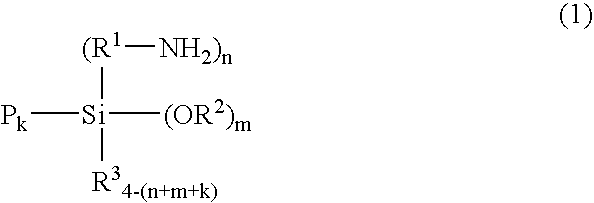Rubber composition
a technology of rubber and composition, applied in the field of rubber, can solve the problems of poor wear resistance, tensile strength and the like of vulcanized rubber, and the inability to obtain sufficient reinforcing effect, and achieve the effects of low rolling resistance, excellent wear resistance and wet skid resistance, and excellent processability
- Summary
- Abstract
- Description
- Claims
- Application Information
AI Technical Summary
Benefits of technology
Problems solved by technology
Method used
Image
Examples
reference example 1 (
Synthesis of Copolymer Rubber A)
[0193] An autoclave reactor having an internal volume of 5 liters in which the atmosphere was replaced with nitrogen was charged with 2,500 g of cyclohexane, 41.3 g of tetrahydrofuran, 125 g of styrene, 365 g of 1,3-butadiene and 0.05 g of divinylbenzene. After the temperature of the contents in the reactor was adjusted to 20° C., 358 mg of n-butyllithium was added to initiate polymerization. The polymerization was conducted under adiabatic conditions, and the maximum temperature reached 87° C.
[0194] At the time when the polymerization conversion reached 99%, 10 g of 1,3-butadiene was added, followed by further polymerization for 5 minutes. Then, 1,720 mg of N,N-bis-(trimethylsilyl)aminopropylmethyldimethoxysilane was added, followed by polymerization for 15 minutes, and 2,6-di-tert-butyl-p-cresol was added to obtain a solution of copolymer rubber A.
reference example 2 (
Synthesis of Copolymer Rubber B)
[0195] An autoclave reactor having an internal volume of 5 liters in which the atmosphere was replaced with nitrogen was charged with 2,500 g of cyclohexane, 9.3 g of tetrahydrofuran, 50 g of styrene and 440 g of 1,3-butadiene. After the temperature of the contents in the reactor was adjusted to 20° C., 358 mg of n-butyllithium was added to initiate polymerization. The polymerization was conducted under adiabatic conditions, and the maximum temperature reached 87° C.
[0196] At the time when the polymerization conversion reached 99%, 10 g of 1,3-butadiene was added, followed by further polymerization for 5 minutes. Then, 725 mg of tin tetrachloride was added, followed by polymerization for 15 minutes, and 2,6-di-tert-butyl-p-cresol was added to obtain a solution of copolymer rubber B.
reference example 3 (
Synthesis of Copolymer Rubber C)
[0197] An autoclave reactor having an internal volume of 16 liters in which the atmosphere was replaced with nitrogen was continuously charged with 1,3-butadiene at 25.0 g / minute and styrene at 14.05 g / minute as monomers, cyclohexane at 237.1 g / minute and tetrahydrofuran at 3.0 g / minute as solvents, and n-butyllithium at 18.67 mg / minute. The temperature of the reactor was controlled at 75° C.
[0198] The polymer rubber solution was continuously discharged at 279.2 g / minute from the first reactor, and silicon tetrachloride was added thereto at 13.6 mg / minute. The resulting solution was continuously introduced into a second reactor to conduct reaction. At an outlet of the second reactor, di-tert-butyl-p-cresol was added in an amount of 0.7 part based on 100 parts of the rubber, thereby obtaining a solution of copolymer rubber C.
TABLE 1ReferenceReferenceReferenceExample 1Example 2Example 3Copolymer RubberABCBonded Styrene Content (%)251036Vinyl Bond Con...
PUM
| Property | Measurement | Unit |
|---|---|---|
| Percent by mass | aaaaa | aaaaa |
| Percent by mass | aaaaa | aaaaa |
| Percent by mass | aaaaa | aaaaa |
Abstract
Description
Claims
Application Information
 Login to View More
Login to View More - R&D
- Intellectual Property
- Life Sciences
- Materials
- Tech Scout
- Unparalleled Data Quality
- Higher Quality Content
- 60% Fewer Hallucinations
Browse by: Latest US Patents, China's latest patents, Technical Efficacy Thesaurus, Application Domain, Technology Topic, Popular Technical Reports.
© 2025 PatSnap. All rights reserved.Legal|Privacy policy|Modern Slavery Act Transparency Statement|Sitemap|About US| Contact US: help@patsnap.com



